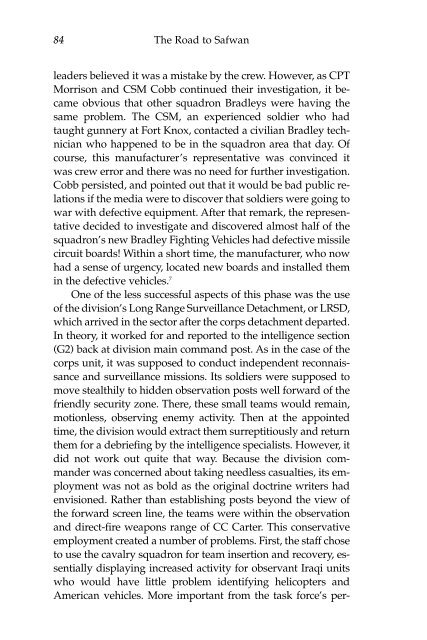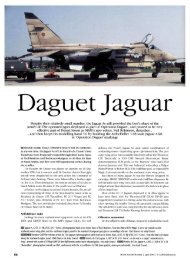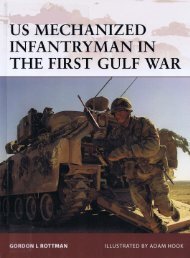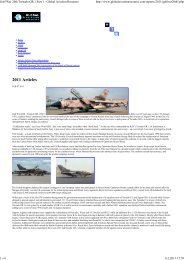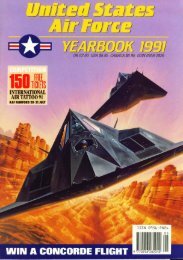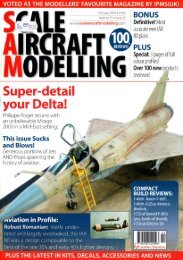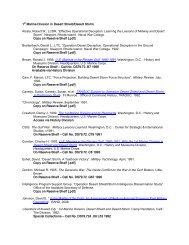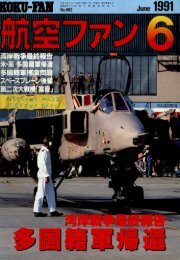The Road to Safwan: The 1st Squadron, 4th Cavalry in the 1991 ...
The Road to Safwan: The 1st Squadron, 4th Cavalry in the 1991 ...
The Road to Safwan: The 1st Squadron, 4th Cavalry in the 1991 ...
Create successful ePaper yourself
Turn your PDF publications into a flip-book with our unique Google optimized e-Paper software.
84 <strong>The</strong> <strong>Road</strong> <strong>to</strong> <strong>Safwan</strong><br />
leaders believed it was a mistake by <strong>the</strong> crew. However, as CPT<br />
Morrison and CSM Cobb cont<strong>in</strong>ued <strong>the</strong>ir <strong>in</strong>vestigation, it became<br />
obvious that o<strong>the</strong>r squadron Bradleys were hav<strong>in</strong>g <strong>the</strong><br />
same problem. <strong>The</strong> CSM, an experienced soldier who had<br />
taught gunnery at Fort Knox, contacted a civilian Bradley technician<br />
who happened <strong>to</strong> be <strong>in</strong> <strong>the</strong> squadron area that day. Of<br />
course, this manufacturer’s representative was conv<strong>in</strong>ced it<br />
was crew error and <strong>the</strong>re was no need for fur<strong>the</strong>r <strong>in</strong>vestigation.<br />
Cobb persisted, and po<strong>in</strong>ted out that it would be bad public relations<br />
if <strong>the</strong> media were <strong>to</strong> discover that soldiers were go<strong>in</strong>g <strong>to</strong><br />
war with defective equipment. After that remark, <strong>the</strong> representative<br />
decided <strong>to</strong> <strong>in</strong>vestigate and discovered almost half of <strong>the</strong><br />
squadron’s new Bradley Fight<strong>in</strong>g Vehicles had defective missile<br />
circuit boards! With<strong>in</strong> a short time, <strong>the</strong> manufacturer, who now<br />
had a sense of urgency, located new boards and <strong>in</strong>stalled <strong>the</strong>m<br />
<strong>in</strong> <strong>the</strong> defective vehicles. 7<br />
One of <strong>the</strong> less successful aspects of this phase was <strong>the</strong> use<br />
of <strong>the</strong> division’s Long Range Surveillance Detachment, or LRSD,<br />
which arrived <strong>in</strong> <strong>the</strong> sec<strong>to</strong>r after <strong>the</strong> corps detachment departed.<br />
In <strong>the</strong>ory, it worked for and reported <strong>to</strong> <strong>the</strong> <strong>in</strong>telligence section<br />
(G2) back at division ma<strong>in</strong> command post. As <strong>in</strong> <strong>the</strong> case of <strong>the</strong><br />
corps unit, it was supposed <strong>to</strong> conduct <strong>in</strong>dependent reconnaissance<br />
and surveillance missions. Its soldiers were supposed <strong>to</strong><br />
move stealthily <strong>to</strong> hidden observation posts well forward of <strong>the</strong><br />
friendly security zone. <strong>The</strong>re, <strong>the</strong>se small teams would rema<strong>in</strong>,<br />
motionless, observ<strong>in</strong>g enemy activity. <strong>The</strong>n at <strong>the</strong> appo<strong>in</strong>ted<br />
time, <strong>the</strong> division would extract <strong>the</strong>m surreptitiously and return<br />
<strong>the</strong>m for a debrief<strong>in</strong>g by <strong>the</strong> <strong>in</strong>telligence specialists. However, it<br />
did not work out quite that way. Because <strong>the</strong> division commander<br />
was concerned about tak<strong>in</strong>g needless casualties, its employment<br />
was not as bold as <strong>the</strong> orig<strong>in</strong>al doctr<strong>in</strong>e writers had<br />
envisioned. Ra<strong>the</strong>r than establish<strong>in</strong>g posts beyond <strong>the</strong> view of<br />
<strong>the</strong> forward screen l<strong>in</strong>e, <strong>the</strong> teams were with<strong>in</strong> <strong>the</strong> observation<br />
and direct-fire weapons range of CC Carter. This conservative<br />
employment created a number of problems. First, <strong>the</strong> staff chose<br />
<strong>to</strong> use <strong>the</strong> cavalry squadron for team <strong>in</strong>sertion and recovery, essentially<br />
display<strong>in</strong>g <strong>in</strong>creased activity for observant Iraqi units<br />
who would have little problem identify<strong>in</strong>g helicopters and<br />
American vehicles. More important from <strong>the</strong> task force’s per-


